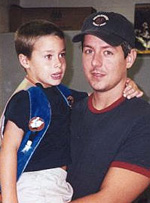A Map (on one’s own palm) of Growing Still
Lance Phillips reviews
Growing Still, by Deborah Meadows
Tinfish Press, 2005
The Dragomoschenko to begin it is appropriate, as his work has the kind of fluid intelligence with THINGS that this work has, and too the affinity for thinking INTO them.
One thinks of Ponge, in that this is a kind of exploration which doesn’t depend on the ‘surreal’, as so much ‘prose’ ‘poetry’ does. This is that which tends to BE thinking rather than mimic it.
Is process divestiture?
Once, when two passed into many, a shifting ruse claimed heritage, when clandestine revolution offered a way to dwell in enunciative loveliness, liquid, accelerated speech.
Once has an introductory power not common to most words, but also engenders a particular expectation: Story. At the risk of making Story the text begins in the minstrel’s stance only not to proceed, rather by foregrounding THINKING in the stead of THOUGHT its process is its own divestiture.
A shock of seed corn so prosaic it takes on ancient aura (it’s hard for me to see the children suffer).
His sense of time could make a bridge dissolve, insert opaque clouds of retrograde intention where Man refuses to parallel Nature, writes upright.
Consider Cinvat bridge.
Consider a much older, CONTINUOUS TIME.
Consider Mysteries of Eleusis.
The text’s use of coincidence, rather than juxtaposition, is striking. Juxtaposition, being a mannerism which ignores coincidence and which often passes for what is called thinking in a text, uses SPACE as a Frame and has a DELINEATED TIME.
Retreat of mystery: a glass pane whose definition clips possibility to pieces.
Coincidence requires attention, while juxtaposition requires only method.
Coincidence has SPACE as an actor, a catalyst and a CONTINUOUS TIME.
Is there such a thing as Image?
When is the image a retort to technique?
When what one remembers is both Image and prediction?
Portraiture exists as a means of forcing an extended image to subvert itself.
Portraiture exists as a technē for divesting a surface.
Having captured the mind of another, set off beyond unlikely sea foam monument, anti-plinth.
An individual becomes “individual” in a portrait—magnified departures from conventions of beauty, the long slide toward quotation.
...a fractured tooth touched again and again, too sharp, too irregular, to let “sleep” on the white bed beyond the small door frame, its time.
Having torn the membrane between one and many, the portrait takes part in tradition, representation of absent people.

Lance Phillips
Lance Phillips has work forthcoming from 1913, Kulture Vulture, Shampoo and Volt. He has published two books, Corpus Socius (2002) and Cur aliquid vidi (2004), both with Ahsahta Press. He lives in Charlotte, NC, with his wife, son and daughter where he edits the interview blog herecomeseverybody.blogspot.com.
it is made available here without charge for personal use only, and it may not be
stored, displayed, published, reproduced, or used for any other purpose
This material is copyright © Lance Phillips and Jacket magazine 2005
The Internet address of this page is
http://jacketmagazine.com/28/phil-mead.html
